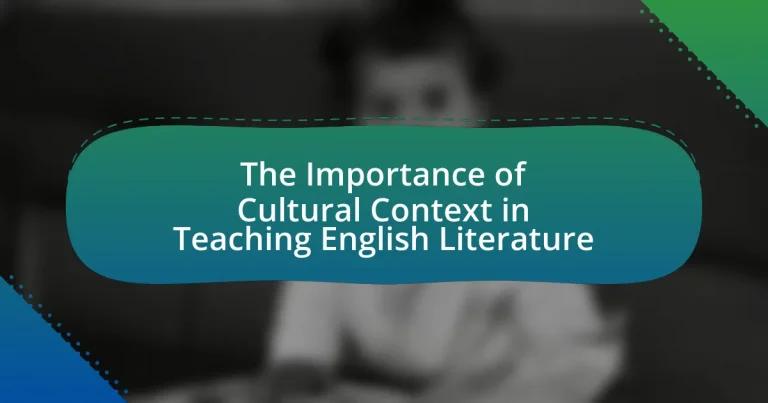Cultural context plays a vital role in teaching English literature, as it enhances students’ comprehension of texts by situating them within their historical, social, and cultural frameworks. This article explores the significance of cultural context in understanding themes, character development, and narrative structures, emphasizing its impact on student engagement and critical thinking. It also addresses the challenges educators face when integrating cultural context into their curriculum and offers strategies for effectively teaching this aspect of literature. Key elements such as historical background, social norms, and language are discussed, highlighting their influence on literary interpretation and the importance of culturally responsive pedagogy in fostering an inclusive learning environment.

What is the Importance of Cultural Context in Teaching English Literature?
Cultural context is crucial in teaching English literature as it enhances students’ understanding of texts by situating them within their historical, social, and cultural frameworks. This contextualization allows learners to grasp the nuances of themes, character motivations, and societal critiques embedded in literary works. For instance, understanding the cultural backdrop of Shakespeare’s plays, such as the Elizabethan era’s social hierarchies and gender roles, enriches students’ interpretations and discussions. Studies have shown that incorporating cultural context in literature education leads to improved critical thinking and engagement, as students can relate literary themes to contemporary issues and their own experiences.
Why is cultural context essential in understanding literature?
Cultural context is essential in understanding literature because it provides the background necessary to interpret themes, characters, and narratives accurately. Literature often reflects the values, beliefs, and social norms of the time and place in which it was created, influencing how stories are told and understood. For instance, understanding the historical context of colonialism is crucial for interpreting works like “Heart of Darkness” by Joseph Conrad, where the implications of imperialism shape the narrative and character motivations. Without this cultural lens, readers may misinterpret the author’s intentions and the societal critiques embedded within the text.
How does cultural context influence character development in literature?
Cultural context significantly influences character development in literature by shaping characters’ beliefs, behaviors, and motivations based on their societal norms and values. For instance, characters in a collectivist culture may prioritize family and community over individual desires, reflecting the cultural emphasis on social harmony. This is evident in works like “Things Fall Apart” by Chinua Achebe, where the protagonist Okonkwo’s actions are deeply rooted in the traditions and expectations of Igbo society. Such cultural frameworks provide readers with insights into the characters’ decisions and conflicts, illustrating how their identities are constructed within specific cultural narratives.
What role does cultural context play in thematic interpretation?
Cultural context significantly influences thematic interpretation by shaping the meanings and values associated with literary works. This context encompasses the historical, social, and cultural backgrounds that inform both the creation of a text and its reception by audiences. For instance, understanding the cultural norms and societal issues present during the time a work was written can reveal deeper insights into its themes, such as identity, power dynamics, and morality. Research by scholars like Edward Said in “Orientalism” illustrates how cultural perceptions can alter the interpretation of themes in literature, demonstrating that themes are not universally understood but are instead filtered through cultural lenses. Thus, cultural context is essential for a nuanced understanding of thematic elements in literature.
How does cultural context affect the teaching of English literature?
Cultural context significantly influences the teaching of English literature by shaping the interpretation and relevance of texts. Educators must consider the cultural backgrounds of their students, as these backgrounds affect how literature is understood and appreciated. For instance, literature that reflects specific cultural experiences can resonate more deeply with students from similar backgrounds, enhancing engagement and comprehension. Research indicates that culturally relevant pedagogy improves student motivation and academic performance, as seen in studies like “Culturally Relevant Pedagogy: Ingredients for Critical Teacher Reflection” by Gloria Ladson-Billings, which highlights the importance of connecting curriculum to students’ cultural contexts. Thus, integrating cultural context into English literature teaching not only enriches the learning experience but also fosters a more inclusive educational environment.
What are the challenges teachers face when integrating cultural context?
Teachers face several challenges when integrating cultural context into their curriculum, primarily including a lack of resources, insufficient training, and diverse student backgrounds. The lack of resources often limits teachers’ ability to access culturally relevant materials that reflect the diverse experiences of their students. Insufficient training in cultural competency can hinder teachers from effectively incorporating cultural context into their lessons, leading to missed opportunities for deeper engagement with the literature. Additionally, the diverse backgrounds of students can create varying levels of familiarity with cultural references, making it difficult for teachers to ensure that all students can connect with the material. These challenges highlight the complexities involved in effectively integrating cultural context in teaching English literature.
How can cultural context enhance student engagement with literature?
Cultural context enhances student engagement with literature by making texts more relatable and meaningful to students’ own experiences. When literature reflects the cultural backgrounds, values, and social issues relevant to students, it fosters a deeper emotional connection and encourages critical thinking. For instance, studies show that students who engage with culturally relevant texts demonstrate increased motivation and comprehension, as they can draw parallels between their lives and the narratives presented. This connection not only enriches their understanding of the literature but also promotes a sense of identity and belonging, ultimately leading to a more immersive and engaging learning experience.

What are the key elements of cultural context in literature?
The key elements of cultural context in literature include historical background, social norms, values, beliefs, and language. Historical background provides insight into the time period in which a work was created, influencing themes and character motivations. Social norms and values shape the behaviors and interactions of characters, reflecting the culture’s expectations. Beliefs, including religious and philosophical views, inform the moral framework within which characters operate. Language, including dialect and idiomatic expressions, conveys cultural identity and enhances authenticity. These elements collectively enrich the reader’s understanding of the text and its relevance to the cultural landscape from which it originates.
How do historical events shape literary works?
Historical events significantly shape literary works by influencing themes, character development, and narrative structures. For instance, the aftermath of World War II led to the emergence of existentialist literature, as seen in works like Albert Camus’ “The Stranger,” which reflects the absurdity of life in a post-war context. Additionally, the Civil Rights Movement in the United States inspired authors such as James Baldwin, whose writings address racial injustice and identity, demonstrating how societal upheaval can drive literary expression. These examples illustrate that literature often serves as a reflection of the historical and cultural milieu in which it is created, providing insight into the human experience during specific periods.
What examples illustrate the impact of historical context on specific texts?
Examples illustrating the impact of historical context on specific texts include George Orwell’s “1984” and Harper Lee’s “To Kill a Mockingbird.” Orwell’s “1984,” published in 1949, reflects the anxieties of the post-World War II era, particularly the rise of totalitarian regimes and the pervasive surveillance state, which can be seen in the novel’s themes of government control and individual freedom. In contrast, “To Kill a Mockingbird,” published in 1960, is deeply rooted in the American Civil Rights Movement, addressing racial injustice and moral growth in the context of 1930s Alabama. The historical backdrop of segregation and social inequality informs the characters’ experiences and the narrative’s moral dilemmas, highlighting the significance of cultural context in understanding the text’s themes and messages.
How can teachers incorporate historical context into their lessons?
Teachers can incorporate historical context into their lessons by integrating relevant historical events, figures, and cultural movements that influenced the literature being studied. For example, when teaching works from the Victorian era, educators can discuss the Industrial Revolution’s impact on society and literature, highlighting how it shaped themes and character development in texts like Charles Dickens’ “Hard Times.” This approach not only enriches students’ understanding of the literature but also fosters critical thinking by connecting literary analysis with historical realities, thereby enhancing engagement and comprehension.
What cultural factors should be considered in literature?
Cultural factors that should be considered in literature include historical context, social norms, language, and values. Historical context influences the themes and characters within a literary work, as seen in works like “To Kill a Mockingbird,” which reflects the racial tensions of the American South in the 1930s. Social norms shape character interactions and plot developments, evident in Jane Austen’s novels, where societal expectations dictate personal relationships. Language plays a crucial role in conveying cultural nuances, as demonstrated in Chinua Achebe’s “Things Fall Apart,” where proverbs and idiomatic expressions reflect Igbo culture. Lastly, values inherent in a culture inform moral lessons and character motivations, as illustrated in the works of Gabriel García Márquez, which often highlight themes of family and community. Understanding these factors enhances the appreciation and interpretation of literature across diverse cultural landscapes.
How do social norms and values influence literary themes?
Social norms and values significantly shape literary themes by reflecting the beliefs and behaviors prevalent in a society at a given time. For instance, literature often explores themes of identity, morality, and social justice, which are influenced by the collective attitudes and expectations of the culture in which it is produced. A concrete example is the Harlem Renaissance, where African American writers like Langston Hughes and Zora Neale Hurston addressed themes of racial identity and social inequality, directly responding to the social norms and values of early 20th-century America. This connection illustrates how literature serves as a mirror to societal values, allowing readers to understand and critique the cultural context in which the work was created.
What is the significance of language and dialect in cultural context?
Language and dialect are significant in cultural context as they serve as primary vehicles for expressing identity, values, and social norms within a community. They reflect historical experiences and cultural heritage, influencing how individuals relate to one another and their environment. For instance, the use of regional dialects can signify belonging to a specific cultural group, while language variations can highlight social hierarchies and power dynamics. Research indicates that language shapes thought processes and cultural perceptions, as demonstrated by the Sapir-Whorf hypothesis, which posits that the structure of a language affects its speakers’ worldview. This underscores the importance of understanding language and dialect in teaching English literature, as it enriches the interpretation of texts and fosters deeper engagement with diverse cultural narratives.

How can educators effectively teach cultural context in English literature?
Educators can effectively teach cultural context in English literature by integrating historical, social, and cultural backgrounds relevant to the texts being studied. This approach allows students to understand the influences that shape characters, themes, and narratives. For instance, discussing the impact of the Harlem Renaissance on African American literature provides students with insights into the cultural and social dynamics of the time, enhancing their comprehension of works by authors like Langston Hughes and Zora Neale Hurston. Additionally, utilizing multimedia resources, such as documentaries and interviews, can further contextualize the literature, making it more relatable and engaging for students. Research indicates that when students grasp the cultural context, their analytical skills improve, leading to deeper discussions and interpretations of the texts.
What strategies can be employed to teach cultural context?
To teach cultural context effectively, educators can employ strategies such as integrating diverse literature, utilizing multimedia resources, and facilitating discussions that connect texts to historical and cultural backgrounds. Integrating diverse literature exposes students to various cultural perspectives, enhancing their understanding of different contexts. For instance, including works from authors of different ethnicities allows students to explore cultural nuances and societal issues relevant to those backgrounds. Utilizing multimedia resources, such as films, music, and art, can provide visual and auditory context that enriches students’ comprehension of the cultural settings in literature. Facilitating discussions encourages students to share their insights and relate personal experiences to the texts, fostering a deeper connection to the cultural context. These strategies collectively enhance students’ appreciation of literature by situating it within its cultural framework, thereby improving their analytical skills and empathy towards diverse cultures.
How can multimedia resources enhance the understanding of cultural context?
Multimedia resources enhance the understanding of cultural context by providing diverse and immersive experiences that engage multiple senses. For instance, visual elements such as videos and images can illustrate cultural practices, while audio resources like music and spoken word can convey emotional nuances and historical significance. Research indicates that students exposed to multimedia content demonstrate improved retention and comprehension of cultural themes, as evidenced by a study published in the Journal of Educational Psychology, which found that students using multimedia tools scored 30% higher on assessments related to cultural understanding compared to those using traditional texts alone. This integration of various media formats allows learners to connect more deeply with the cultural narratives present in English literature, fostering a richer educational experience.
What role do discussions and debates play in teaching cultural context?
Discussions and debates are essential in teaching cultural context as they facilitate critical thinking and deeper understanding of diverse perspectives. Engaging students in dialogue about cultural themes encourages them to analyze and interpret literature within its historical and social frameworks. For instance, a study by the National Council of Teachers of English found that classroom discussions significantly enhance students’ ability to connect literary texts to their cultural backgrounds, fostering empathy and awareness. This interactive approach not only enriches students’ comprehension but also promotes respect for cultural differences, making literature more relatable and impactful.
What are some best practices for integrating cultural context in literature lessons?
Integrating cultural context in literature lessons can be effectively achieved through several best practices. First, educators should incorporate diverse literary works that reflect various cultural perspectives, allowing students to engage with texts that resonate with different backgrounds. For example, including authors from various ethnicities and regions can enhance students’ understanding of global narratives.
Second, discussions about the historical and social contexts surrounding a text can deepen comprehension. Educators can provide background information on the cultural setting in which a work was created, such as the socio-political climate during the author’s lifetime, which can illuminate themes and character motivations.
Third, utilizing multimedia resources, such as films, music, and art from the culture represented in the literature, can create a richer learning experience. This approach allows students to visualize and hear the cultural context, making the literature more relatable and engaging.
Lastly, encouraging students to share their own cultural experiences and perspectives can foster a more inclusive classroom environment. This practice not only validates students’ backgrounds but also enriches discussions, as peers learn from each other’s insights.
These best practices are supported by research indicating that culturally responsive teaching enhances student engagement and comprehension in literature studies.
How can teachers assess students’ understanding of cultural context?
Teachers can assess students’ understanding of cultural context through various methods such as discussions, reflective writing, and project-based assessments. Engaging students in discussions about cultural references in literature allows teachers to gauge their comprehension and ability to connect themes to real-world contexts. Reflective writing assignments encourage students to articulate their insights and personal connections to the cultural elements presented in the texts. Additionally, project-based assessments, where students create presentations or artistic interpretations of cultural contexts, provide tangible evidence of their understanding. Research indicates that these methods not only enhance comprehension but also foster critical thinking skills, as highlighted in the study “Cultural Context in Literature Education” by Smith and Johnson, published in the Journal of Educational Research.
What resources are available for educators to learn about cultural context?
Educators can access various resources to learn about cultural context, including academic journals, online courses, and professional development workshops. For instance, the Journal of Cultural Research in Art Education provides peer-reviewed articles that explore cultural context in education. Additionally, platforms like Coursera and edX offer courses on cultural competence and diversity in education, which help educators understand the significance of cultural context. Professional organizations, such as the National Council of Teachers of English, also provide resources and guidelines for integrating cultural context into teaching practices. These resources are essential for educators aiming to enhance their understanding of cultural influences in literature and improve their teaching effectiveness.
What practical tips can enhance the teaching of cultural context in literature?
Incorporating diverse cultural perspectives into literature lessons enhances the teaching of cultural context. Educators can achieve this by selecting texts from various cultures, which allows students to explore different worldviews and experiences. For instance, using works by authors such as Chimamanda Ngozi Adichie or Gabriel García Márquez exposes students to rich cultural narratives. Additionally, integrating multimedia resources, such as films or music from the culture represented in the literature, can provide a more immersive understanding. Engaging students in discussions about the historical and social contexts of the texts fosters critical thinking and empathy. Research indicates that students who study literature within its cultural context demonstrate improved comprehension and appreciation of the material, as evidenced by studies conducted by the National Council of Teachers of English.




